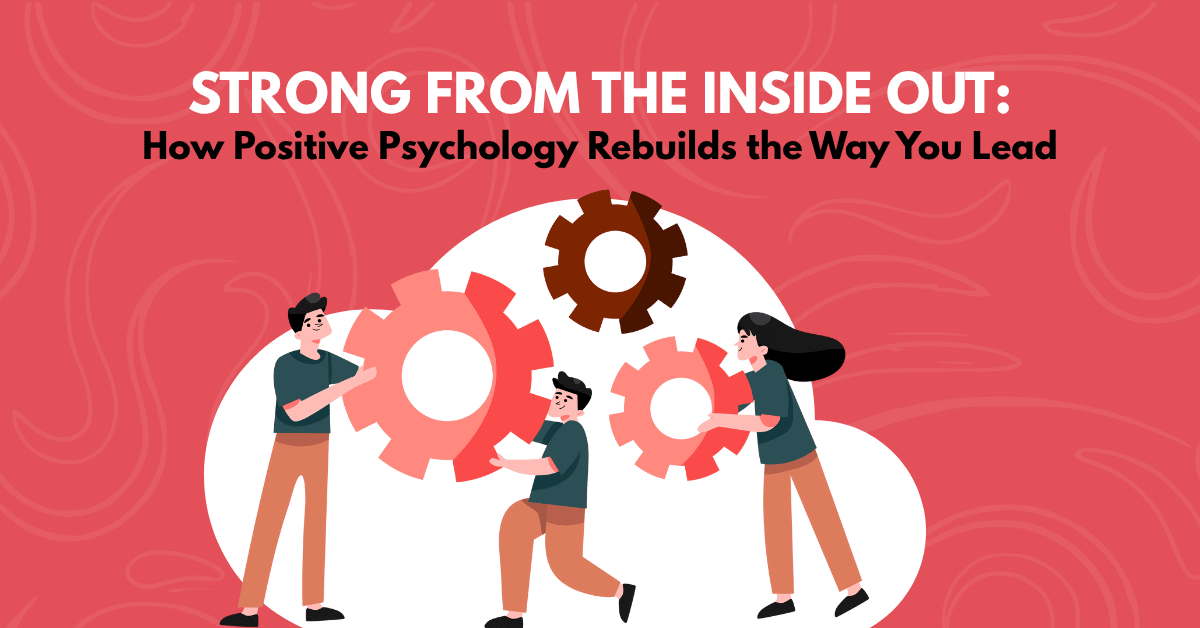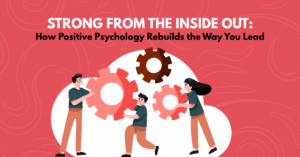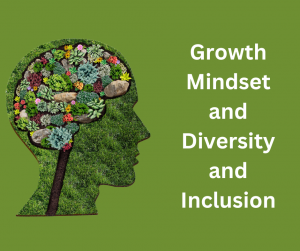Some days, leadership feels like you’re holding the whole thing together with sheer will. The demands don’t slow down. The inbox fills faster than you can respond. And while you’re pouring into others, your own energy keeps dipping lower. If you’re leading through transformation, expansion, or recovery, chances are your internal capacity is stretched.
And yet, the most effective leaders aren’t the ones with all the answers. They’re the ones who lead from alignment. From energy. From self-awareness.
This is where positive psychology becomes more than a feel-good theory. It becomes a strategic foundation. At PPCaDI, we help leaders ground their work in what’s proven to build teams that thrive, not just perform. In this article, we’ll walk you through four principles that can help you recalibrate your leadership from the inside out.
The Problem Behind the Problem
The traditional model of leadership focuses heavily on outputs — deliverables, performance metrics, problem-solving. But what’s often left out of the equation is the inner world of the leader. How you think, feel, and relate deeply affects how you lead.
The truth is, your leadership energy becomes the emotional blueprint for your team. If you walk in tight and on edge, they feel it, even if nothing’s said out loud. If you’re overwhelmed, reactive, or burned out, it shows up in decision-making, communication, and morale.
Positive psychology offers a powerful shift. Instead of leading from deficit or control, you lead from intention, alignment, and strength. This isn’t just idealism, it’s backed by behavioral science, brain research, and what we know about human motivation. It’s how sustainable cultures are built.
The Four Anchors of Positive Psychology in Leadership
When a leader is grounded in positive psychology, their influence shifts from managing performance to unlocking potential. These four principles aren’t new; they’re human. But applying them consciously can elevate everything from team culture to your own sense of clarity and satisfaction. Let’s walk through each one, not as traits to acquire, but as tools to activate.
Positive Emotions: Fuel, Not Filler
While often dismissed as “soft,” emotions like curiosity, hope, and gratitude are central to how people perform under pressure. Research shows that positive emotions broaden our cognitive scope, we become more creative, more flexible, and more socially connected. As a leader, you set the emotional tone for your team. Even small cues like celebrating a quick win, showing appreciation, or pausing for humor in a tense moment create ripple effects.
Leaders who cultivate positivity aren’t ignoring problems; they’re creating the conditions for better problem-solving.
Try this: At your next team meeting, ask, “What energized you this week?” instead of jumping into updates. Watch the shift.
Strengths-Based Leadership: Lead with What’s Strong
Strengths-based leadership begins with a mindset shift: people grow faster when they build on what’s right, not just correct what’s wrong. That includes you. You’re not leading to be well-rounded; you’re leading to be well-aligned.
Every leader has team members who shine in different ways — analytical thinkers, empathetic listeners, action-takers, and big-picture visionaries. A strengths-based approach means intentionally designing roles, tasks, and growth paths around these unique capabilities.
Leaders who apply this principle:
- Know their own top strengths and how those strengths show up under pressure
- See their team through a lens of possibility, not deficiency
- Customize roles, feedback, and recognition around individual capacity
Meaning and Purpose: The Leadership Multiplier
Purpose is what transforms tasks into meaningful work. It’s also what keeps people engaged during challenge, change, or ambiguity. As a leader, your job isn’t just to assign tasks, it’s to connect the dots between effort and impact.
Too often, meaning is seen as personal, something people need to find on their own. But in reality, leaders are the interpreters of meaning in an organization. You provide the context that helps others see why their work matters.
Try asking:
- What value does this project contribute to the bigger picture?
- Can my team see the “why” behind the “what” we’re doing?
When people feel that their work aligns with their values and purpose, they become more resilient, more innovative, and more committed.
Psychological Resilience: Capacity to Recover and Reframe
Resilience isn’t just the ability to endure. It’s about the ability to adapt, recalibrate, and grow from challenge. It’s built in moments of pressure, but developed through daily choices: How you recover. How you respond. How you reflect.
Leaders who model psychological resilience build trust. Not because they’re immune to stress, but because they respond to it with clarity and intention. That kind of leadership gives teams permission to be human and high-performing.
Resilience is cultivated by:
- Creating room for recovery, not just output
- Naming stress without shame
- Framing setbacks as learning opportunities rather than personal failures
Strategies to Rewire Your Leadership from the Inside Out
Here are four entry points to shift from theory to practice. These are simple, but impactful when done consistently.
- Check Your Leadership Energy
Start each week by asking: What emotional energy am I bringing into the room? Track what energizes you and what drains you. Adjust your week based on where your strengths can lead more powerfully. - Integrate Strength Conversations into 1:1s
Instead of only focusing on development goals, ask: What are you enjoying most in your work right now? When do you feel most effective? Use these cues to reframe roles and responsibilities when possible. - Frame the Why Behind the Work
For every new initiative or meeting, start with “why this matters.” It doesn’t have to be dramatic. It just needs to connect work to meaning. - Debrief Resilience, Not Just Results
After setbacks, don’t just ask what went wrong. Ask: What did we learn? What helped you stay grounded? What could support us better next time? These small debriefs strengthen future capacity.
PPCaDI Integration: What Makes This Work
This approach pulls from VIA Strengths, Purpose Mapping, and Growth Mindset — all evidence-based frameworks that turn internal insight into performance leverage. At PPCaDI, we believe real change happens when leaders operate from their core and not just their competencies. That’s the real power here. These these aren’t traits you’re either born with or without. They’re skills you can build, starting right where you are.
“The skills of flourishing — positive emotion, engagement, meaning, and accomplishment — are measurable and teachable.”
— Dr. Martin Seligman, Flourish
If you’re ready to lead with more clarity, capacity, and connection to what really matters, start with this:
- Take the VIA Strengths Assessment
→ https://www.viacharacter.org
Gain language for your leadership identity. - Book a 1:1 Coaching Session or Leadership Team Workshop
Let’s explore how these principles can support you or your team in real-time challenges. https://www.ppcadi.com/programs/








